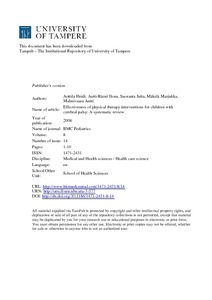Effectiveness of physical therapy interventions for children with cerebral palsy: A systematic review
Anttila, Heidi; Autti-Rämö, Ilona; Suoranta, Jutta; Mäkelä, Marjukka; Malmivaara, Antti (2008)
Anttila, Heidi
Autti-Rämö, Ilona
Suoranta, Jutta
Mäkelä, Marjukka
Malmivaara, Antti
2008
BMC Pediatrics 8
14
This publication is copyrighted. You may download, display and print it for Your own personal use. Commercial use is prohibited.
Julkaisun pysyvä osoite on
https://urn.fi/urn:nbn:uta-3-577
https://urn.fi/urn:nbn:uta-3-577
Kuvaus
BioMed Central Open access
Tiivistelmä
Background
To assess the effectiveness of physical therapy (PT) interventions on functioning in children with cerebral palsy (CP).
Methods
A search was made in Medline, Cinahl, PEDro and the Cochrane library for the period 1990 to February 2007. Only randomized controlled trials (RCTs) on PT interventions in children with diagnosed CP were included. Two reviewers independently assessed the methodological quality and extracted the data. The outcomes measured in the trials were classified using the International Classification of Functioning, Disability and Health (ICF).
Results
Twenty-two trials were identified. Eight intervention categories were distinguished. Four trials were of high methodological quality. Moderate evidence of effectiveness was established for two intervention categories: effectiveness of upper extremity treatments on attained goals and active supination, and of prehensile hand treatment and neurodevelopmental therapy (NDT) or NDT twice a week on developmental status, and of constraint-induced therapy on amount and quality of hand use. Moderate evidence of ineffectiveness was found of strength training on walking speed and stride length. Conflicting evidence was found for strength training on gross motor function. For the other intervention categories the evidence was limited due to low methodological quality and the statistically insignificant results of the studies.
Conclusion
Due to limitations in methodological quality and variations in population, interventions and outcomes, mostly limited evidence on the effectiveness of most PT interventions is available through RCTs. Moderate evidence was found for some effectiveness of upper extremity training. Well-designed trials are needed especially for focused PT interventions.
To assess the effectiveness of physical therapy (PT) interventions on functioning in children with cerebral palsy (CP).
Methods
A search was made in Medline, Cinahl, PEDro and the Cochrane library for the period 1990 to February 2007. Only randomized controlled trials (RCTs) on PT interventions in children with diagnosed CP were included. Two reviewers independently assessed the methodological quality and extracted the data. The outcomes measured in the trials were classified using the International Classification of Functioning, Disability and Health (ICF).
Results
Twenty-two trials were identified. Eight intervention categories were distinguished. Four trials were of high methodological quality. Moderate evidence of effectiveness was established for two intervention categories: effectiveness of upper extremity treatments on attained goals and active supination, and of prehensile hand treatment and neurodevelopmental therapy (NDT) or NDT twice a week on developmental status, and of constraint-induced therapy on amount and quality of hand use. Moderate evidence of ineffectiveness was found of strength training on walking speed and stride length. Conflicting evidence was found for strength training on gross motor function. For the other intervention categories the evidence was limited due to low methodological quality and the statistically insignificant results of the studies.
Conclusion
Due to limitations in methodological quality and variations in population, interventions and outcomes, mostly limited evidence on the effectiveness of most PT interventions is available through RCTs. Moderate evidence was found for some effectiveness of upper extremity training. Well-designed trials are needed especially for focused PT interventions.
Kokoelmat
- Artikkelit [6140]
